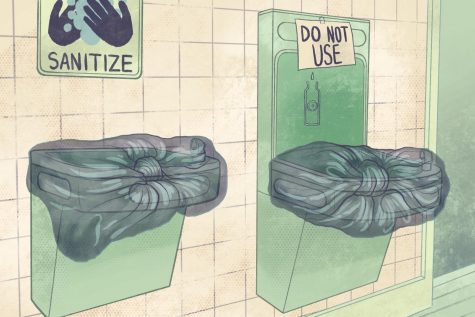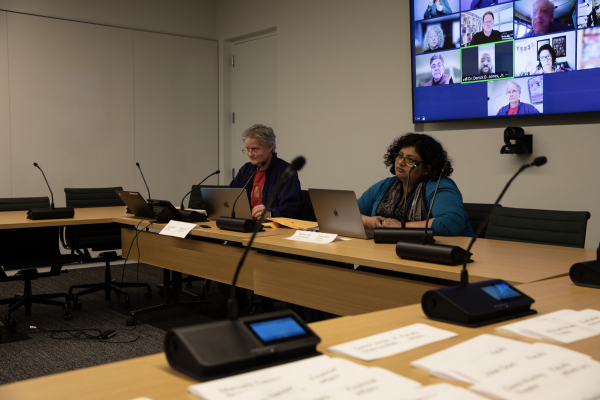Stagnant water in buildings brings health concerns, experts say
July 1, 2020

Due to coronavirus-related building closures, college campuses like Columbia are working to ensure a safe return and dealing with stagnant water increasing the possibility of bacteria and serious illness.
Normally, when buildings are open and in use, water is constantly moving and therefore “cleansing itself of chemicals,” according to Caitlin Proctor, a Lillian Gilbreth Postdoctoral Fellow at Purdue University of Indiana.
Because many buildings on college campuses have been closed since March due to coronavirus health concerns, water systems—including toilets, faucets, water fountains, refilling stations, communal showers and underground pipes—have been sitting unused for nearly four months.
The Illinois Department of Public Health, or IDPH, issued a memorandum May 13 through its Plumbing and Water Quality Program to building owners and public water supply operators with guidance on “maintaining water quality and safety in building water systems and in portable water distribution systems during periods of reduced use.” It also included advice on how to properly return building water systems to regular use.
The memorandum stated a lack of water use will increase water age and stagnation in water systems, which then “degrades water quality by corroding pipes and plumbing materials, accumulating sediment in water systems, and reducing disinfectant levels.”
This then contributes to the growth and spread of waterborne pathogens and increases the concentrations of metals like iron, lead and copper. It also creates unpleasant tastes, colors and odors, according to the memorandum.
Andrew Whelton, an associate professor of Civil Engineering and Environmental and Ecological Engineering at Purdue, said when water sits for too long, it increases the probability of high levels of chemicals, which can potentially cause health concerns including nausea, vomiting, stomach cramping and diarrhea due to contaminated water.
Proctor said the growth of bacteria and pathogens can cause respiratory health effects through inhalation, similar to the coronavirus, or COVID-19.
One of the more recent health concerns due to stagnant water is Legionnaires’ disease, which is a type of pneumonia caused by legionella bacteria.
In Lake County, Illinois, a man was tested four times for COVID-19 because of his severe symptoms and temperature of 104.7, but results came back negative each time, according to WGN-TV reporting on June 18. It was later found he had Legionnaires’ disease and the Lake County Public Health Department has initiated an investigation into how the man contracted the disease.
Unlike COVID-19, Legionnaires’ disease is not transferable from person to person. However, Proctor said people who are immunocompromised “tend to be vulnerable to the pathogens that grow in water,” so people recovering from COVID-19 are more defenseless against the pathogens found in water systems.
Both Proctor and Whelton have been sampling the water systems of different buildings in Indiana and preparing them for people to safely return.
Whelton said the two of them remove every faucet in the building, pull every aerator off faucet heads out and clean them with toothbrushes, disinfect the aerator, flush all stagnant water out of the building’s water system, measure water quality and use thermometers to test if all old water is gone.
Proctor said she suggests buildings keep water moving daily and open faucets frequently to flush out stagnant water.
She said another option would be to conduct a complete building flush but it may pose concerns of creating aerosols, and people doing the flushing would need to wear personal protective equipment.
Proctor said the measures taken to reduce the risk of coronavirus spread might have secondary effects on other systems like water and plumbing.
In order to keep occupancy low in bathrooms, some campuses have closed off a number of stalls, but because those stalls are not being used, it creates stagnation at individual points, she said.
Angela Hackel, United States Environmental Protection Agency spokesperson, said the agency is working to “support communities to safely reopen following precautions taken to slow the spread of COVID-19.”
“[The] EPA recommends that building owners and managers take proactive steps as to protect public health by minimizing water stagnation during closures and taking action to address building water quality prior to reopening,” Hackel said.
Lambrini Lukidis, associate vice president of Strategic Communications and External Relations, said Columbia’s Facilities and Operations staff were trained by the Building Owners and Management Association, or BOMA, on how to manage water systems in buildings during the campus shutdown.
Lukidis said after the training, a water management program was developed for the college which follows Centers for Disease Control and Prevention guidelines. In late April, facilities engineers began implementing the program where all water systems were drained and flushed of stagnant water, Lukidis said.
She said this includes cooling towers, boilers, drinking fountains, toilets and any water source used for washing hands or drinking.
“It is an ongoing practice that Facilities [staff] will continue as part of maintaining our buildings and keeping it safe for occupants,” Lukidis said. “We are going to bag the water fountains to help prevent the spread of the [coronavirus].”
The CDC released guidelines May 7 for “reopening buildings after prolonged shutdown or reduced operation,” which outlines “Legionella guidance for people with weakened immune systems and the use of respiratory protection when flushing water systems.”
IDPH’s memorandum included a recommended checklist for building owners which included contacting water suppliers; verifying backflow devices have been tested in the last 12 months; flushing cold and hot water systems; ensuring all traps on drain, waste and vent systems are properly sealed; and ensuring all plumbing fixtures have been properly cleaned and disinfected prior to use.
In the college’s updated reopening plans June 17, it was announced touchless faucets will be installed in all bathrooms on campus.
Whelton said even if college campuses are taking necessary steps to ensure clean water throughout its buildings, everyone still needs to be cautious about the “new normal.”
“Universities and institutions should be communicating to the faculty, staff, students and parents about what they’re doing to make campus safe,” Whelton said.
















